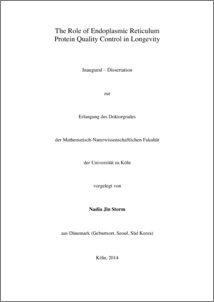Storm, Nadia Jin
(2014).
The Role of Endoplasmic Reticulum Protein Quality Control in Longevity.
PhD thesis, Universität zu Köln.

![[img]](https://kups.ub.uni-koeln.de/style/images/fileicons/application_pdf.png)  Preview |
|
PDF
Dissertation_Nadia_Storm_Final_Version_Revised.pdf
- Updated Version
Download (25MB)
|
Abstract
Aging has become a major challenge for Western countries, as it is estimated that two-thirds of all deaths are related to age-associated diseases. This includes cancer, diabetes, neurodegenerative disorders, cardiovascular diseases, etc. Biological aging is defined as the progressive loss of function over time, and even though the last decades of research have shed light upon many cellular processes involved in aging, many mechanisms remain to be understood.
Cellular quality control mechanisms have been implicated in aging, as proteins involved in these are altered during biological aging. Thus, cellular processes become dysfunctional and normal growth is impaired. The different compartments of cells each have distinct quality control mechanisms to ensure a rapid turnover of proteins, cellular structures and lipids. This includes the mitochondrial unfolded protein response, the endoplasmic reticulum unfolded protein response, the cytosolic heat shock response and autophagy. Protein quality control is an essential mechanism to maintain protein homeostasis. Additionally, it has been found to be associated with aging in a wide range of organisms from yeast to mammals.
The endoplasmic reticulum is the major site for lipid biosynthesis, protein maturation and membrane synthesis. Because of its essential role in protein maturation, the endoplasmic reticulum has a vastly developed protein quality control system, which ensures re-folding or degradation of mis- or unfolded proteins. Some of these pathways, such as the endoplasmic reticulum associated degradation pathways and the endoplasmic reticulum unfolded protein response pathways have been linked to aging. Additionally, autophagy has been suggested to play a role in compartment-specific protein homeostasis. Recent studies have further indicated that these pathways are essential for normal lifespan, and more importantly, that long-lived organisms have elevated activity of one or more of these pathways. This led us to ask whether selecting for mutants with improved protein quality control mechanisms would confer longevity.
Indeed, we found that to be true. By performing a forward genetic screen, selecting for C. elegans mutants with increased ability to cope with tunicamycin-induced endoplasmic reticulum stress, we identified four independent gain-of-function mutations in glutamine-fructose-6-phosphate amino-transferase 1 (gfat-1) that led to lifespan extension. GFAT-1 regulates the rate-limiting step of the hexosamine pathway, which uses fructose-6-phosphate from glycolysis to synthesize UDP-N-Acetylglucosamine (UDP-GlcNAc). UDP-GlcNAc is a precursor for N-glycans. In addition, gfat-1 gain-of-function mutants had enhanced activity of different cellular degradation pathways, which led to alleviated proteotoxicity of several C. elegans models of neurodegenerative disorders, and by supplementing wild type animals with GlcNAc (a derivate of UDP-GlcNAc) we were able to mimic the longevity and amelioration of toxic proteins observed in gfat-1 gain-of-function mutants. These findings suggest novel therapeutic approaches to promote health and extend lifespan through endogenous molecule modulation of protein quality control, and hence, might be important for future studies of neurodegenerative disorders.
From the tunicamycin resistance screen, we also identified several long-lived mutants with defects in the chemosensory system. Such deficiency has previously been associated with longevity. These mutations also have improved protein quality control mechanisms, as they had decreased levels of aggregated proteins in the endoplasmic reticulum upon introduction of an unstable endoplasmic reticulum resident protein. In addition to the screen, we also found a handful of wild C. elegans isolates with improved ability to cope with tunicamycin-induced endoplasmic reticulum stress. Together, these studies may shed light upon novel mechanisms to modulate endoplasmic reticulum quality control mechanisms and induce longevity.
| Item Type: |
Thesis
(PhD thesis)
|
| Creators: |
| Creators | Email | ORCID | ORCID Put Code |
|---|
| Storm, Nadia Jin | storm@age.mpg.de | UNSPECIFIED | UNSPECIFIED |
|
| Contributors: |
| Contribution | Name | Email |
|---|
| Author | UNSPECIFIED | UNSPECIFIED |
|
| URN: |
urn:nbn:de:hbz:38-56569 |
| Date: |
8 April 2014 |
| Language: |
English |
| Faculty: |
Faculty of Mathematics and Natural Sciences |
| Divisions: |
Faculty of Mathematics and Natural Sciences |
| Subjects: |
Life sciences |
| Uncontrolled Keywords: |
| Keywords | Language |
|---|
| Longevity | UNSPECIFIED | | Protein Quality Control | UNSPECIFIED | | Protein Aggregation Disorders | UNSPECIFIED |
|
| Date of oral exam: |
8 April 2014 |
| Referee: |
| Name | Academic Title |
|---|
| Antebi, Adam | Prof. Dr. |
|
| Refereed: |
Yes |
| URI: |
http://kups.ub.uni-koeln.de/id/eprint/5656 |
Downloads per month over past year
Export
Actions (login required)
 |
View Item |


